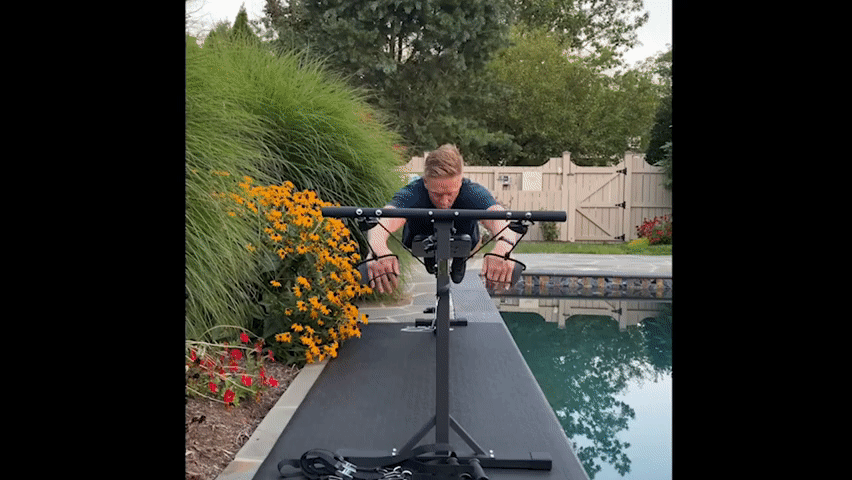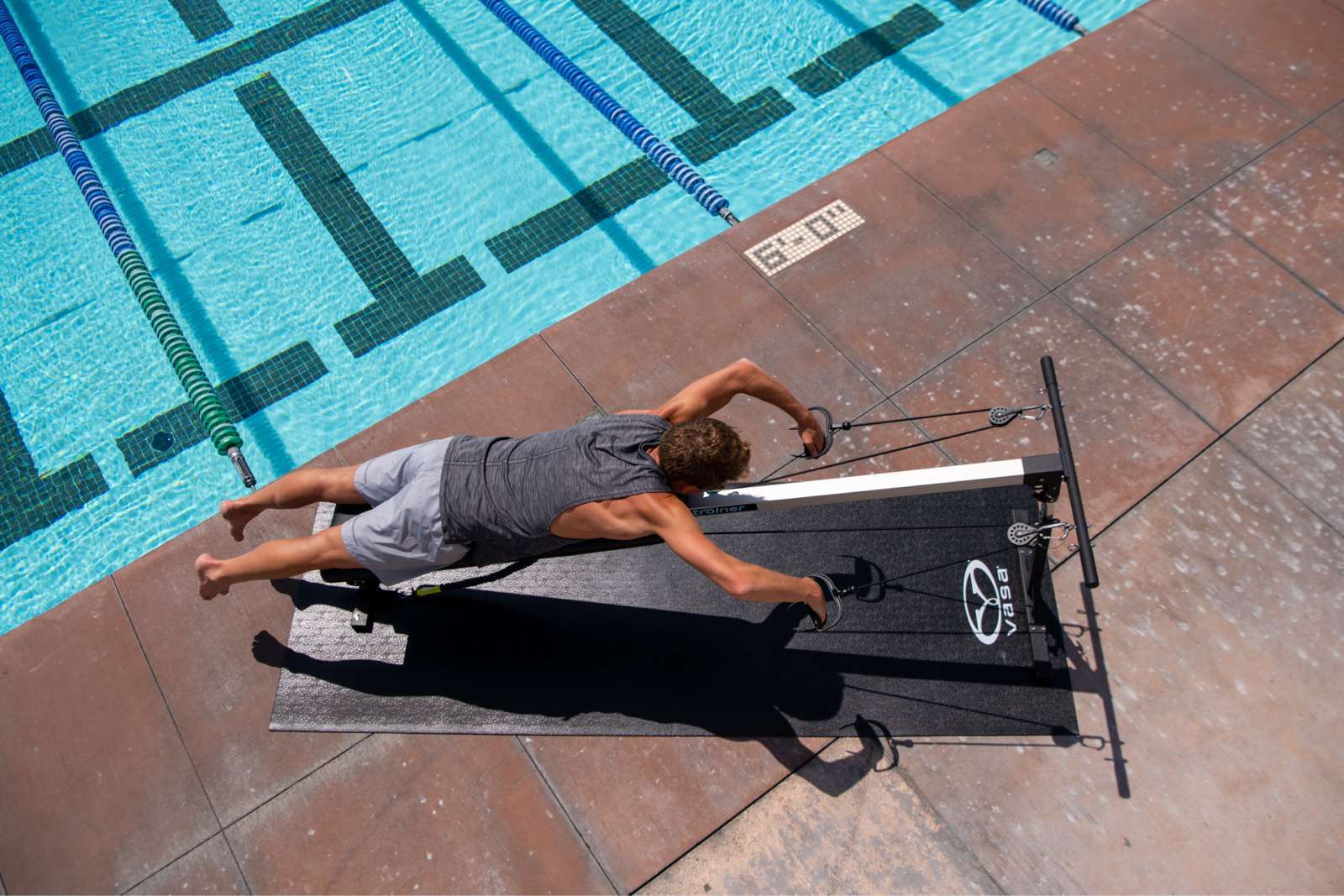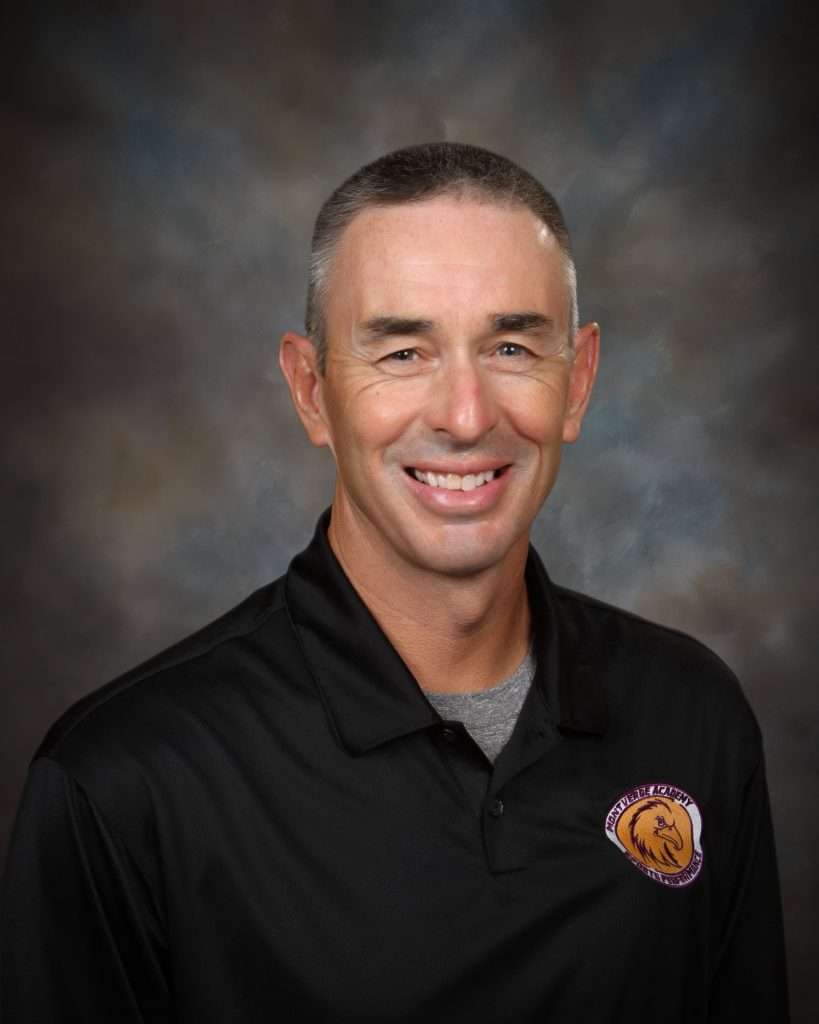By Tim Crowley

Butterfly pulling (double-arm pulling) is excellent for developing strength, endurance, and power. Its benefits transfer very well to the pull phase of freestyle, which is a plus for open-water swimmers and triathletes. Most triathletes and adult-learned swimmers likely did not learn the Butterfly stroke as a youth swim team athlete. Learning how to swim a complete Butterfly stroke is very challenging for anyone. However, in this article, we only want to use the double-arm pull (DAP) or butterfly pull for variety and specific strength, which aids in developing a strong open-water stroke. Many triathletes do not want to take the time to learn a proper fly stroke and may be hesitant to do it at the pool out of fear of looking silly trying to do a butterfly.
The good news is that the Vasa SwimErg (and the Vasa Trainer Pro) is perfectly suited to help develop this important component, which transfers well to open water speed and proficiency. With a couple of short key workouts each week (10-15 minutes), any athlete of any ability can learn a powerful fly pull. Going forward, this will be called a Double-Arm Pull (DAP).

Using Vasa to Practice Your DAP
Whether you use a Vasa Trainer or Vasa Swim Ergometer, you have the perfect tool to develop swim-specific strength within the pull phase of freestyle by using a double-arm pull. When using the ergometer, you have 2 options: You can use it in “erg mode,” pulling the cords and getting data from the PM3 power meter, such as power output and stroke rate. You can also use the SwimErg like the Vasa Trainer Pro by adding a Trainer Strap System attachment. Either works well for the workouts outlined below.

Another advantage of Double-Arm (butterfly pulling) training on the Vasa is that it puts less stress on the shoulders by using an “underwater “ recovery. When doing DAP, the recovery stroke path is low, tracing the pulling phase in the opposite direction. This low recovery stroke path reduces the chance of impingement overuse injuries, common in swimmers.
Why train the double-arm pull (DAP) on the Vasa?
- Technique is easier to master: Unlike swimming in the pool, where timing and coordination of upper and lower body are essential when pulling on the Vasa SwimErg, setting up a proper catch and accelerating your stroke through the back end is essential. You can focus on power development with the feedback from the monitor. Acceleration endurance is a key capacity to endurance swimming. This article will explain what it is and how to develop it: https://vasatrainer.com/blog/acceleration-endurance/
- Less low back stress: The Vasa SwimErg supports your back while lying on the padded bench, allowing you to focus solely on upper body strength, power, and endurance.
- Power data: While viewing the PM3 monitor on a Vasa Swimming ergometer (or when using the companion app, Trainer Day), you can access instantaneous feedback such as power output, stroke rate, speed, and specific workouts. These metrics will allow you to measure success and progress your workouts as you improve.
- Time efficiency: One of the great benefits of training on a Vasa SwimErg is the results you can get with as little as 10 minutes per session. Double-arm pull workouts do not take long and perfectly complement pool swimming or strength sessions.
- Supine double arm pull: To get additional core training during DAP intervals or to relieve stress on the lower back, lie supine on your back while doing the DAP. This will engage the core muscles more and allow for a slightly deeper and easier breathing pattern.
Coach Nielsen’s Thoughts on DAP
Coach Eric Nielsen is a big proponent of the supine DAP and has this to say:
“Supine double-arm fly pulling is great because the athlete has no direct pressure on the chest. IMO, this can help the athlete feel more of an open armpit and engage the lats for a stronger pull.
Supine fly pull with legs in 90/90 position IMO something to progress to as this really engages the core. Once comfortable in that position, you can gently flex the core (crunch) while engaging the pull.”
Coach Eric Nielsen
DAP workouts
In the workouts below, it is best to do an easy warm-up of 2 to 5 minutes of easy freestyle or double arm pull. Workouts can be 10 to 20 minutes in total time and consist of a work-to-rest ratio of 1:1. It is important that you start with shorter workouts and maintain high quality and minimal drop-off in power and stroke rate, which can you can easily monitor on the erg or the Trainer Day app.
Suggested progressions
15 seconds on/ 15 seconds rest, continuous for 10 to 20 minutes
20 seconds on/20 seconds rest, continuous 10 to 10 minutes
30 seconds on/30 seconds rest, continuous 10 to 20 minutes
Recommended progressions would be to start with the 15 seconds on, 15 seconds off for 10 minutes, adding 2 minutes per week until you reach 20 minutes, then go to 20 seconds on, 20 seconds off starting at 10 minutes total, adding 2 minutes per week up to 20 minutes, and continue the same pattern for 30 seconds on 30 seconds off.
DAP Fartlek Intervals
Another effective way to develop specific strength using a double arm pull is to integrate it into your longer freestyle sets on the Vasa Trainer or the Vasa Erg. This will develop swim-specific strength and power and simulate the high-intensity surges that can occur in open-water swims or triathlons.
Example 1:
3 to 5-minute easy warm-up.
15 to 20 minutes continuous freestyle swim with a 30-second DAP surge every 3 minutes.
Example 2:
3 to 5-minute easy warm-up
3 to 4 sets of (4 minutes as 50 seconds freestyle/10 seconds DAP) one-minute complete rest after each set of 4 minutes.
Whether you’re looking to develop swim-specific strength or strength endurance in your freestyle stroke, including double arm pulling as a dedicated workout or mixed into your other freestyle, Vasa workouts are a great way to get faster. These workouts can replace your pool sessions or supplement your workouts on days between pool sessions.
About Tim Crowley

Tim Crowley is a well-respected coach, and we are privileged to have him as a vital part of the Vasa community. He has contributed useful dryland for swimmers’ workout and technique videos, which you can find in the Vasa Video Library

